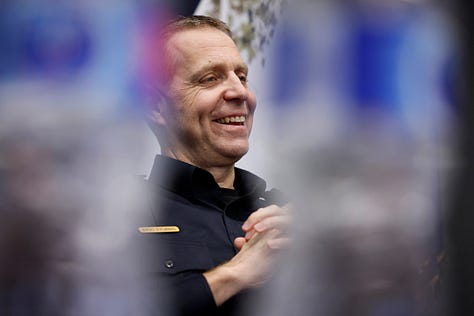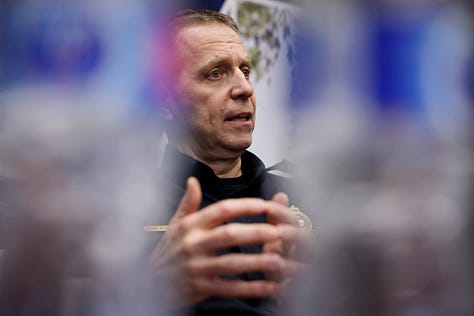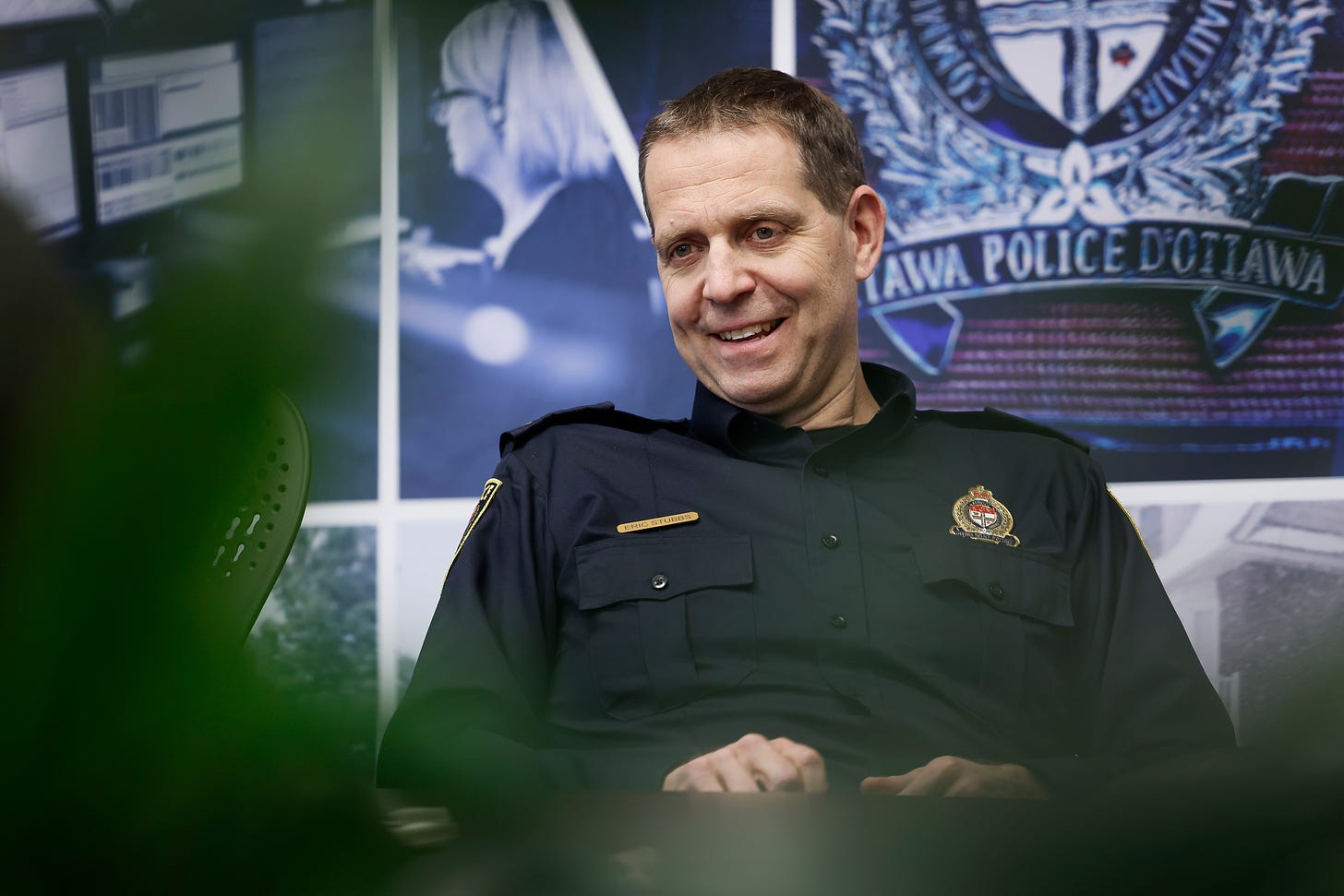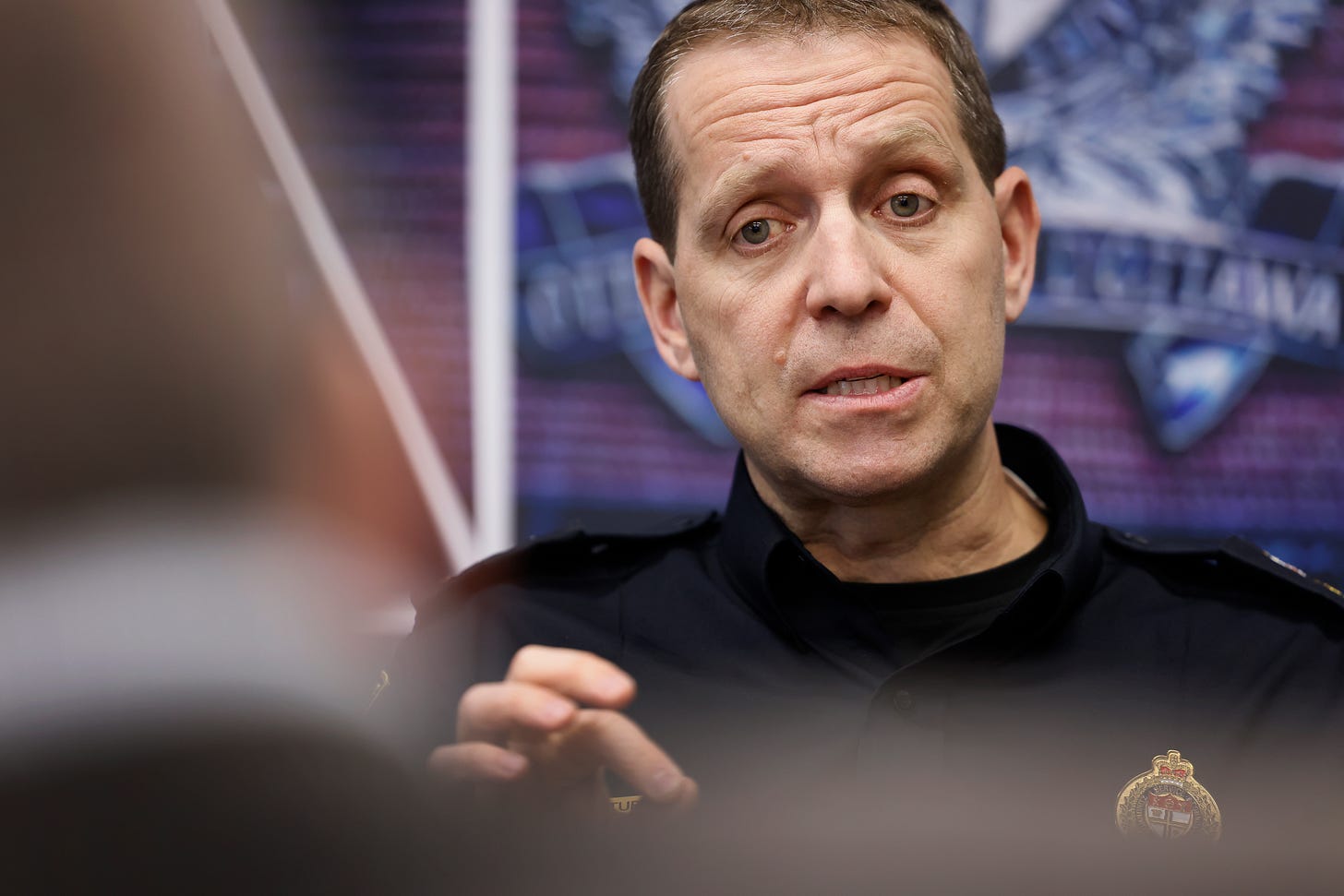"We do want to avoid enforcement"
Ottawa's new police chief on the delicate work of handling big protests
I was grateful, and a little surprised, when the new Chief of the Ottawa Police Service, Eric Stubbs, agreed to talk to me about how the force has changed since 2022’s Freedom Convoy debacle. Stubbs’ hiring was announced in the middle of the Rouleau Commission testimony — and only days before a mayoral election, by a civilian Police Services Board. His 30-year background in the RCMP, much of it policing some of the most contentious Indigenous-rights protests in British Columbia, made him controversial before he got here. I had told Stubbs’s staff up front that I wanted to ask him about thorny topics.
If there’s one thing that interested me most about the testimony before Justice Paul Rouleau’s Public Order Emergency Commission, it’s the debate over how to police large protests. Depending on who’s protesting, who’s policing and who’s watching, the options range from prompt arrests to a sustained hands-off.
What I learned last autumn during the Rouleau Commission testimony is that the thinking in most Canadian police forces on where to strike that balance has been changing in recent years, toward much greater reluctance to start arresting people right away. Instead, police “liaison teams” are used, in the words of a Canadian Association of Chiefs of Police document that describes this thinking, to “build and foster relationships” between the police and the protesters — in the hope that most of the protesters will go home feeling they’ve had a good day.
From the day I first heard about this philosophy last October, I’ve felt it’s a significant and little-understood element of police doctrine in a world where large public protests are likely to be a constant feature of modern city life. Especially in a city like Ottawa. It struck me as inherently controversial: some observers will always disagree with where police strike that balance between indulgence and repression. This debate, as it played out during the Freedom Convoy, is a central theme of my short book An Emergency In Ottawa, which Sutherland House will publish next Tuesday. It featured in an excerpt from the book that The Globe and Mail published over the weekend.
And as I discovered when we sat down to talk in his office at OPS headquarters on Elgin Street, it featured in Stubbs’s life as recently as this past weekend.
I’m leaving the paywall off this piece because I want Ottawans and other Canadians to be able to share this insight into the thinking behind police work. But as always, I’m grateful for paying subscribers who help me do this work full-time, pay professional photographers, and travel to stories. If you want to become a paying subscriber, here’s your chance.
“I can tell you this,” Stubbs told me early in our Monday interview. “This weekend, we had some protests downtown. I went down there, just in a pair of jeans and a jacket. And just walked around and spoke to some OPS members and just watched the protests for a little bit.”
The protest was called “National Shutdown” in an expression of high hopes among some remnants of the Freedom Convoy crowd. The weekend’s specific topic was election interference; the protesters’ hope, once again, was that Justin Trudeau could be pushed out of office. Turnout was modest. This protest didn’t last.
“The people that were on the ground amongst the protesters — the only people that were — were Police Liaison Team,” Stubbs said. “Everybody else was [told], ‘Back away, give them their space to protest.’ It was peaceful, was lawful, and it was safe. That was the three criteria we look at. Those three things. And this largely was. They were skirting a few things, but we could manage it.”
The OPS by now has a pretty good idea who is likely to march for Trudeau’s removal in Ottawa these days. “We have good relationships, particularly with the local organizers that are part of this movement,” he said. “Sometimes people come from outside, and they're harder to make friends with because they don't have much invested in the community. They're here for a day, or whatever. Might be a couple hours. Stir it up and leave, right?”
Building up those “good relationships” is a goal of this type of work. “It's all about talking, right? You know, it's the same thing for a frontline person on a call go into a domestic [dispute]. It's all about talking. It's all about communication. The success we have in the policing world, 98% has to do with how you can talk and communicate. Everything else on the belt” — his hands fell to his duty belt, from which handcuffs and a weapon might hang — “helps in certain circumstances, but it's rare. Gotta talk. And that's what it's all about.”
Since it came up in the Rouleau Commission testimony, I have discussed this notion of policing as relationship-building and ostentatiously non-judgmental bridge-building with colleagues and friends, including on Émilie Nicolas’s French-language Détours podcast. So I’ve gotten used to one response: Oh, sure, they have to talk to truckers, but they don't have to talk to Indigenous people. They just move in when it's the Wet’suwet’en. How does Stubbs respond to that?
“Look. There is no doubt that the police liaison role is to engage all stakeholders,” he said. “So it's the protesters; it's the people that are being protested against — industry, government, whatever it might be; and then its periphery people as well, too. It could be a community that's affected. It could be a local government. It could be neighbours, right? A business that's affected, whatever, like we saw here. It's everybody. All the stakeholders. That has always been our goal. Now you have to have a willing participant to speak to. In the Wet’suwet’en file, we certainly spoke to the hereditary chiefs, we spoke to protesters that were on the ground and had been there for years, all the time. So it” — extended engagement with the protesters as stakeholders — “certainly did occur.”
At some point, unless police are very lucky, engagement will stop paying dividends and then there’ll usually be some arrests. Given the burden of public attention, social media, changed expectations, is that call harder to make than it used to be?
“Well, I think our whole industry is under the microscope every time we do enforcement, be it [against] the vulnerable population, be it the homeless, mental health, addiction. Every time there's a big enforcement run — unless it's [arrests of people with ties to] organized crime, people go, 'Hey, why do you need to do that?' That's just the general environment that we're living in.”
Before the arrests begin in B.C., “we do everything we can to try to avoid it,” Stubbs said. “And I can tell you, I personally was engaging high-level federal and provincial government officials, trying to get engagement prior to enforcement, trying to resolve it. Because we rarely can resolve the issue at hand, right? Whether it's pro-abortion, pro-life — we can't solve that. Whether it's to cut down trees or not, or to, you know, to drill oil or not — we can't resolve these things. But we can try to get people to a table to try to talk. And that's often what we're doing when we're trying to avoid enforcement. We do want to avoid enforcement, if we can.”
Sometimes, circumstances — and even courts — can constrain police choices. “If there's an injunction by the Supreme Court — and that's often what I was dealing with. There's a [provincial] Supreme Court judge that says there's an injunction here; for argument's sake, that road, that building, that area shall be cleared, so the applicants, usually industry, can do their job. So we have that judicial demand put on us. So that does force our hand.
Only up to a point, however. “I can tell you that, in my experience, with some of this, the industry, when they get these things, you know, they get it on a Monday, they say, 'Okay, go Tuesday, open it up.' And we will take multiple, multiple steps. It could be six weeks before we do anything. And people don't realize that. They think, ‘Oh, they go in there, like, this quick.’ That's not the case. We are lobbying governments; we're working with the protesters; working with industry; trying to get an understanding of where everybody's at, before we go in.
“And again, it's hard to please everybody. It's a no-win situation for police. The protesters are upset. Industry wants it done tomorrow. Government wants this. To have all the stakeholders say, 'perfect job?' Rarely does that happen. So it's an activity, that enforcement activity, that will always come with unhappy people. Generally. “



I asked: “You say you'd rather not enforce, and it helps if everyone comes to the table. We heard from the federal government [during the Freedom Convoy], 'There's no point in me coming to a table because these are bad people, and they're so disorganized that I don't even know who I would talk to.' Would you urge public authorities to get over that instinctive reaction?”
Stubbs replied: “Well, every situation is different. Usually you do have a person or a group of people that are in charge of a protest. Usually they will identify themselves. So you have a fairly good idea of who you need to talk to. But I can tell you this, it's also a strategy of these protesters not to have a leader. And we've seen that in some other protests. But we will still talk to people — and usually make some headway there.
“But to your question, I encourage people, despite what it may look like, to always try to talk. We always want talking if it's an option. But every situation is different. To use that as a line in cement, not in sand -- you must, and you will -- that's not always the case. But that has to be discussed: Why or why not? ‘We want to engage in dialogue. Let's do it.’ ‘Well, we can't.’ ‘Well, give me the rationale. Why? I need to know that.’”
This weekend’s group of Convoy dead-enders had people in it whom the police could talk to? Sure, he said. To be sure, not all of them were interested in talking. “It's never perfect. It's never perfect. But the protesters always need to know that we always want to talk to them. And look, we do this, not daily, but multiple times a week. It doesn't matter. It could be a small protest, you know, a march to the Iranian, the Cuban, the Chinese, the Russian embassy. Whatever. The US Embassy. We're always talking to people. ‘What's your intentions?’ ‘We want to march.’ ‘OK, then stay on the sidewalk.’ ‘We want to go on the road.’ ‘Well, they can't go on the road.’ Then maybe we facilitate one block of road. To bend a little bit, right? It's not all about being inflexible, it's being fair. And can we keep them safe? Can we make it legal? Are you going to be peaceful? If you are, we can talk.”
Another surprise for me at the Rouleau Commission was that, while these ideas are common currency to some senior managers in various Canadian police organizations, they were news to others. Especially, a year ago, to some senior officers in the OPS. Patricia Ferguson, who acted as a deputy chief to Stubbs’s predecessor Peter Sloly and continues in a similar role, testified that few senior OPS officers were familiar with the Canadian Association of Chiefs of Police’s National Framework for Police Preparedness for Demonstrations and Assemblies, which was published just over three years ago and discusses much of what I’m talking about here.
It’s remarkable, when you think about it: Whatever else it is, Ottawa is the national capital of organized political protest. Keeping up on the latest thinking might be a good idea. Stubbs was reluctant to criticize what went on before his arrival. Like Sloly, he’s an outsider coming late, after a long career outside the OPS, to command a force with a substantial number of OPS lifers. He’s plainly reluctant to ruffle feathers. “You know, there's a lot of frameworks and a lot of policy and a lot of regulations that we go by. To keep on top of all of it, 100%, is difficult.”
OK, but on this Framework for Demonstrations and Assemblies, has Stubbs briefed and trained up the OPS on those ideas, compared to where things stood in 2022?
“Yes.”
OK, what does that look like?
First, Stubbs emphasized, a lot of the after-action work was underway before his appointment. From February until Stubbs’s arrival in November, Interim Chief Steve Bell had worked on repairing the many weaknesses the OPS showed during the Convoy occupation: command and control, planning, intelligence collection and distribution, and cooperation with other police forces. Stubbs has continued that work.
“As it relates to PLT [Police Liaison Team], we have built that team. We're training more people. I think I saw six of them yesterday [at the so-called National Shutdown event] alone…. We had a whole bunch deployed in two vans. They went out, and that was their job. So they're being deployed all the time. There's no doubt that they are now a fabric of how we respond to protests.” Are those full-time assignments? “A couple are. Most of them, you know, it's an off-the-side-of-the-desk issue. But I'll just say this. We pick people that have very good communication skills. You have to be able to talk, you have to be very professional, you need a lot of patience, and you have to know how to build relationships.”
On changes to intelligence gathering, he said, “I won't go into a lot of details… but we certainly have built teams that are now dedicated to intel gathering, writing reports and conducting risk assessments. We're working a lot closer with our RCMP and OPP colleagues, who have larger machines that are dedicated to that type of work. So we're exchanging information and assessing that intel a lot better.”
So everything’s fixed? Stubbs was quick to offer that he’s not there yet. “The funding that we have for our full-time team here — I'm looking for more funding. I mean, we're the capital of Canada. It makes Ottawa what it is, so it's not a negative thing. But because of the presence of the government here, it does come along with a lot of protests. So we just need to work with our partners a little bit more to get some funding to have a program that is more robust.”
I couldn’t talk to Stubbs without asking about recent cases where Ottawa police have worn the “Thin Blue Line” symbol, for instance at a charity hockey game. “I can say that I am speaking to the OPA, to both associations” — the Ottawa Police Association and the Ontario Senior Officers’ Police Association, two police unions that have displayed the symbol — “about it, but I'm doing it very quietly. And I'm not going to make this a public event in terms of trying to resolve this issue. I'm just taking a path. But I want to I want to see some resolution, I want to see this angst addressed, but it's going to take some time.”
Is policing simply harder now than it used to be? Downtown Ottawa feels more like a rough neighbourhood than I ever remember. “No doubt about it.” Before leaving the RCMP, he attended the annual meeting of the Union of BC Municipalities. “I think we had 23 municipalities come speak to me, and the commanding officers. Of the 23, 20 of them mentioned their concern about the downtown cores in their respective communities.”
Here, in the day-to-day life of cities climbing out of crisis as in other aspects of police work, “it's a balance in the policing world,” Stubbs said. “I'll just exaggerate. The spectrum is [on one end], do nothing. They're marginalized or vulnerable people. Let the social agencies sort it out. The other [end], as I've been told — people have told me as a police chief — 'You've got to clean that up down there.' And there's only one way that I, as a police force, clean things up. And that's by enforcement.
“Now, what's the balance? I've always said that we have a piece of a pie down there, in terms of people that are prolific offenders, creating multiple victims a day, sometimes 20, 30 victims a day depending on what they're doing. It could be shoplifting, theft from vehicles, accosting in the street, whatever the case may be. We have an obligation as a police service to to protect people down there. Particularly from people that are violent, creating multiple, multiple victims a day — we have to do something.
“My preference would be, if they have mental health issues, they have addiction issues — or they just are a thief. They're a criminal. That's an option. We have to remember, we do have criminals. But if they have an issue to address, can we guide them to a social agency to say, 'Okay, get some treatment, or you're from this community, you've got more supports there or family, can we get you back to your community? Can we get you a home or whatever? Or are you going through the justice system, and we're going to charge you? Because you're refusing all of this, but yet you're still creating these victims every day. We can't have that. We've got to do something.’ That's my perspective on it. But it's that balance of the hug and the hammer, right? Where are you going to be on that spectrum?
“I've dealt with this issue for years, to be quite frank, and I've met a lot of people that you just have a lot of empathy for. You're checking them out of a jail cell in the morning, and they're struggling. And you know it's gonna be another tough day for them. It's tough. It's tough. You have empathy. You just wish that you could do more to help.”




I think one thread you need to consider is the fact that when military or para-military (i.e. police) personnel are faced with an 'active service' situation, failure is common. That is, while the individuals are trained, they may struggle to perform well while under fire as it were. Training and real life are two very different things and many do fine in training but poorly in the pinch. We forget the stress and how disconcerting riots and protests and violence actually is for those on the front line. Often command and control breaks down, senior leadership is at sixes and sevens as to what to do and, let's say, sub-optimal outcomes result.
We see this all the time. Note the complete breakdown of the rural RCMP detachments in Nova Scotia when faced faced with Portapique killer. Note the breakdown of the Washington Capitol police during Mr. Trump's riot.
Most police never have to face the kinds of crisis faced by the OPS or the rural RCMP in Nova Scotia. The 'system' may have a solution or provide the necessary training, but the individuals on the spot will either do well or fail. They fail less often than we have a right to expect. The majority of police never draw their guns in a thirty year career. When at Year 25 they suddenly are faced with a life or death situation they may struggle to come up with the optimal solution. I have great empathy for the police in these cases.
All said, the new OPS chief strikes me as bang on with regard to communications with protesters and the criminal element. Doesn't always work but often does and never hurts.
Good article.
That last topic really struck me. Police have to deal with the tip of the mental health iceberg (small numbers of people perhaps but with very serious health issues).
Do we need a Royal Commission on Mental Health? It seems like as a society we keep trying to sweep the issue under the carpet and content ourselves with tidying up around the edges. Maybe we assume it’s intractable but I bet a look around the world would show that we’re not implementing the resources and best practices really needed to really move the needle.
And perhaps the pendulum has swung too far in terms of patient autonomy when instead some humane and evidence-based but mandatory treatment is the best course of action? Housing too of course is critical.